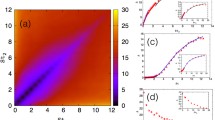Summary
A study has been made of the development of a collision efficiency calculation model for the interaction of charged drops in an external electric field over an extended range of Reynolds numbers. The method of superposition of flow fields obtained from the numerical solutions of the Navier-Stokes equations in case of liquid drop was used for the calculations. The available Reynolds numbers range is 0 to 45. The model was developed as a program for IBM-PC compatible computers and has been tested with recently published data.
Similar content being viewed by others
References
Beard, K. V., Pruppacher, H. R., 1971: A wind tunnel investigation of collection kernels for small water drops in the air.Quart. J. Roy. Meteor. Soc.,97, 242–248.
Beard, K. V., Grover, S. N., 1974: Numerical collision efficiencies for small raindrops colliding with micron size particles.J. Atmos. Sci.,31, 543–550.
Beard, K. V., 1976: Terminal velocity and shape of cloud and precipitation drops aloft.J. Atmos. Sci.,33, 851–864.
Belyaev, S. P., Kim, V. M., Matveev, V. N., 1984: On coagulation of charged and neutral cloud drops. Proceedings of the 9th International Cloud Physics Conference. Tallinn, USSR, v1, 127–130.
Davis, M. H., 1964: Two charged spherical conductors in a uniform electric field.Quart. J. Mech. Appl. Math.,17, 499–511.
Davis, M. H., 1965: The effect of electric charges and fields on collision of very small cloud drops. Proc. Intern. Cloud Physics Conf., Tokyo and Sapporo, Meteoror. Soc. Japan. 118–120.
Forsythe, G. E., Malcolm, M. A., Moler, C. B., 1977:Computer Methods for Mathematical Computations. Englewood Cliffs., N. J.: Prentice-Hall, 280 pp.
Hocking, L. M., 1959: The collision efficiency of small drops.Quart. J. Roy. Meteor. Soc.,85, 44–50.
Kim, V. M., Mamonova, I. G., 1988: On coagulation of charged and neutral drops radii 100–250 and 1–10 μm. (In Russian) Atmospheric electricity. Proceedings of III All Union Symposium. Leningrad Hydrometeoizdat, 123–126.
Klett, J. D., Davis, M. H., 1973: Theoretical collision efficiencies of cloud droplets at small Reynolds numbers.J. Atmos. Sci.,30, 107–117.
Krasnogorskaya, N. V., 1965: The influence of electrostatic force on coagulation of particles of close sizes. (In Russian)Izvestia Acad. of Sci. USSR, Phys. Atmos. and Ocean,1, 339–345.
Langmuir, I., 1948: The production of rain by chain reaction in cumulus clouds at temperatures above freezing.J. Meteorol.,5, 157–192.
LeClair, B. P., Hameliec, A. E., Pruppacher, H. R., 1970: A numerical study of the drag on a sphere at low and intermediate Reynolds numbers.J. Atmos. Sci.,27, 308–315.
Lee, I. Y., 1992: Comparison of cloud microphysics parameterizations for simulation of mesoscale clouds and precipitation.Atmos. Environ.,26A, 2699–2712.
Lin, C. L., Lee, S. C., 1975: Collision efficiency of water drops in atmosphere.J. Atmos. Sci.,32, 1412–1418.
Neizvestnyi, A. I., Kozbunenko, A. G., 1980: Experimental measurements of collection efficiency of water droplets of comparable sizes. (In Russian).Izvestia Academy of Sci. USSR, Phys. Atmos and Ocean.,16, 389–396.
Ochs, H. T., Beard, K. V., 1984: Laboratory measurements of collection efficiencies for accretion.J. Atmos. Sci.,41, 863–867.
Ochs, H. T., Czys, R. R., Beard, K. V., 1986: Laboratory measurements of coalescence efficiencies for small precipitation drops.J. Atmos. Sci.,43, 225–232.
Plumlee, H. R., Semonin, R. G., 1965: Cloud droplet collision efficiency in electric fields.Tellus,18, 356–363.
Proudman, I., Pearson, J. R. A., 1957: Expansion at small Reynolds number for the flow past a sphere and circular cylinder.Mech. Fluids,2, 237–249.
Pruppacher, H. R., Klett, J. D., 1978:The Microphysics of Clouds and Precipitations, Dordrecht: D. Reidel, 714 pp.
Rivkind, V. Ya., 1976: Investigation of problem of stationary motion of drop in flow of viscous incompressible liquid (In Russian).Doklady Acad. Sci. USSR.,227, 1071–1074.
Rivkind, V. Ya., Riskin, G. M., 1976: The flow structure of the spherical drop motion in the liquid media in the range of transitional Reynolds numbers. (In Russian).Izvestia Acad. Sci. USSR, Mechanics of liquid and gas. 1, 8–15.
Sartor, J. D. Miller, J. S., 1975: Relative cloud droplet trajectory computation. Proc. Intern. Cloud Physics Conf., Tokyo and Sapporo, Meteor. Soc. Japan, 108–112.
Schlamp, R. J., Grover, S. N., Pruppacher, H. R., Hameliec, A. E., 1976: A numerical investigation of the effect of electric charges and vertical external electric fields on the collision efficiency of cloud drops.J. Atmos. Sci.,33, 1747–1755.
Schlamp, R. J., Grover, S. N., Pruppacher, H. R., Hameliec, A. E., 1979: A numerical investigation of the effect of electric efficiency of cloud drops: Part II.J. Atmos. Sci.,36, 339–349.
Semonin, R. G., Plumlee, H. R., 1966: Collision efficiency of charged cloud droplets in electric fields.J. Geophys. Res.,71, 4271–4278.
Shafrir, U., 1965: Some nonlinear effects in the collision efficiency problem.J. Geophys. Res.,70, 4491–4500.
Takahashi, T., 1973: Measurement of electric charge of cloud droplets, drizzle, and raindrops.Rev. Geophys. Space Phys.,11, 903–924.
Takami, H., Keller, H. B., 1969: Numerical solution of steady viscous flow around a circular cylinder at low Reynolds numbers.Phys. Fluids., [Suppl. II],12, 1151–1156.
Author information
Authors and Affiliations
Additional information
With 7 Figures
Rights and permissions
About this article
Cite this article
Klimin, N.N., Rivkind, V.Y. & Pachin, V.A. Collision efficiency calculation model as a software tool for microphysics of electrified clouds. Meteorl. Atmos. Phys. 53, 111–120 (1994). https://doi.org/10.1007/BF01031908
Received:
Revised:
Issue Date:
DOI: https://doi.org/10.1007/BF01031908



